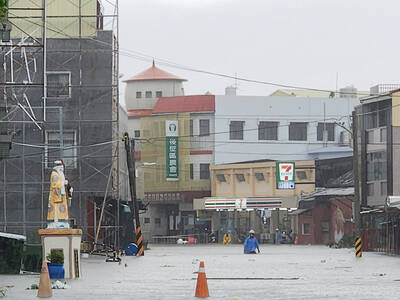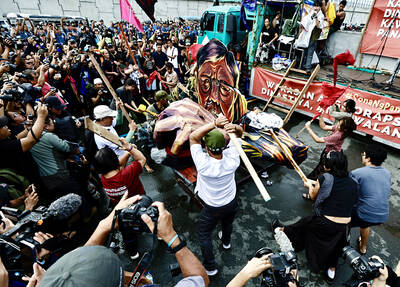Australian prospectors used to be grizzled old blokes who went off into the hills with their swag and a bottle of whisky, hoping to find a few nuggets of gold and strike it rich. But the astonishing resources boom in Australia's vast outback, which has turned the once-dowdy western capital of Perth into a glitzy city of millionaires, has changed all that.
Nowadays, miners are tycoons who wear designer suits, live in mansions and travel by helicopter or private plane seeking vast fields of iron ore and other minerals. There are countless members of this new class of entrepreneurs who have profited from the boom, including one who used to sell fish on the beach but recently sold his firm for A$3.1 billion (US$2.76 billion).
Fueled by China's rapid rate of urbanization and demand from other Asian markets, mining companies all across the country are struggling to keep up with orders, expanding at breakneck speed and seeking new deposits.
Last week's A$60 billion bid by the world's largest mining company, BHP Billiton, for its rival, Rio Tinto, has crystalized the sense of urgency as businesses seek to cash in on the good times.
There is considerable expansion in South Australia, Queensland and the Northern Territory, but the most rapid growth continues to be in Western Australia and particularly in the Pilbara region, where the rich, red earth is bursting with minerals.
The Hamersley Range alone has been estimated to contain 30 billion tonnes of iron ore, enough to supply the world's steelmakers for decades.
Both BHP and Rio Tinto have huge presences in the Pilbara and are pouring billions of dollars into upgrading road, railways and ports for their iron-ore concessions.
There are also vast deposits of oil and liquefied natural gas in the region. Although the law of supply and demand will eventually bring the resources boom to an end, or at least to a plateau, it remains a super-charged market for now. Investors are rushing to join in and the Japanese, who have been partnering Australian companies for decades, are now up against the Chinese and others such as the Russian steel billionaire Alisher Usmanov and the Ukrainian billionaire Gennadiy Bogolyubov.
Tony Poli, a former accountant, is a prime example of the emerging breed of miner. Sitting in the boardroom of his company's plush, air-conditioned offices in the south of Perth, he is turning over a large chunk of iron ore in his hands, the source of much of his wealth.
Poli's company, Aquila Resources, has coal and iron ore assets of A$1.2 billion and Poli's 30 percent stake in the company means he is worth about A$365 million.
"It might just be some grazing land or a rocky environment, but then you come back 12 months later and there is a hole in the ground and a huge plant bringing the stuff to the surface. That's the thrill," he says.
Michael Kiernan is another mining entrepreneur riding the crest of the boom. A larger than life character, his office in a western suburb of Perth has an outsized desk, leather chesterfield chairs and a variety of model lorries on display.
"China is a hungry dragon and west Australia is feeding it," he says. Territory Resources, Kiernan's group of six public companies, has a combined market value of A$1.5 billion and mines iron ore, mineral sands, copper and vanadium.
Yet another, Kerry Harmanis, who used to sell fish from a van he operated on a beach in Perth 20 years ago, has just sold his nickel mining company, Jubilee Mines, to Xstrata for A$3.1 billion, netting him A$500 million.
The resources boom has brought enormous prosperity to Perth, which now looks and feels a bit like Dallas and is slowly shedding its image as a dull, provincial city. There is not a square metre of commercial space to spare in the central business district because of ancillary companies flooding into the region, said Paul Rogers at Coldwell Banker Real Estate.
John Nicolau, chief economist at Perth's Chamber of Commerce and Industry, says the local economy is growing by 6 percent a year, double the rate of the rest of the country, and is forecast to continue at the same rate for at least the next three years. The mining sector accounts for 27 percent of Western Australia's output and millions of dollars in royalties are flowing from the mining companies into the coffers of the federal government.
There is a downside. There is a critical lack of skilled and unskilled workers in Western Australia, both to service the mining boom and to do ordinary jobs within the state.
Many professional people such as teachers and police officers are abandoning their careers for high-paying jobs in the mining industry.
Infrastructure is struggling to cope with demands being placed on roads, electricity and water services, and the price of property has skyrocketed. Two million people live in Western Australia and, with a workforce of 1.1 million, an estimated 400,000 people will be needed in the next decade to service the mining industry.
Meanwhile, mining tycoons such as Andrew "Twiggy" Forrest, said to be closing in on the title of Australia's richest man, with a paper fortune of A$6 billion, continue raking it in. The share price of his Fortescue Metals Group surged 19 percent last week on the announcement of another billion-tonne iron ore discovery in the Pilbara.
Forrest's company, established only four years ago, has a net worth of A$17 billion, but has yet to even dig its first ounce of ore, let alone start shipping it to China.
That starts in May.

Rainfall is expected to become more widespread and persistent across central and southern Taiwan over the next few days, with the effects of the weather patterns becoming most prominent between last night and tomorrow, the Central Weather Administration (CWA) said yesterday. Independent meteorologist Daniel Wu (吳德榮) said that based on the latest forecast models of the combination of a low-pressure system and southwesterly winds, rainfall and flooding are expected to continue in central and southern Taiwan from today to Sunday. The CWA also warned of flash floods, thunder and lightning, and strong gusts in these areas, as well as landslides and fallen

WAITING GAME: The US has so far only offered a ‘best rate tariff,’ which officials assume is about 15 percent, the same as Japan, a person familiar with the matter said Taiwan and the US have completed “technical consultations” regarding tariffs and a finalized rate is expected to be released soon, Executive Yuan spokeswoman Michelle Lee (李慧芝) told a news conference yesterday, as a 90-day pause on US President Donald Trump’s “reciprocal” tariffs is set to expire today. The two countries have reached a “certain degree of consensus” on issues such as tariffs, nontariff trade barriers, trade facilitation, supply chain resilience and economic security, Lee said. They also discussed opportunities for cooperation, investment and procurement, she said. A joint statement is still being negotiated and would be released once the US government has made

SOUTH CHINA SEA? The Philippine president spoke of adding more classrooms and power plants, while skipping tensions with China over disputed areas Philippine President Ferdinand Marcos Jr yesterday blasted “useless and crumbling” flood control projects in a state of the nation address that focused on domestic issues after a months-long feud with his vice president. Addressing a joint session of congress after days of rain that left at least 31 dead, Marcos repeated his recent warning that the nation faced a climate change-driven “new normal,” while pledging to investigate publicly funded projects that had failed. “Let’s not pretend, the people know that these projects can breed corruption. Kickbacks ... for the boys,” he said, citing houses that were “swept away” by the floods. “Someone has

‘CRUDE’: The potential countermeasure is in response to South Africa renaming Taiwan’s representative offices and the insistence that it move out of Pretoria Taiwan is considering banning exports of semiconductors to South Africa after the latter unilaterally downgraded and changed the names of Taiwan’s two representative offices, the Ministry of Foreign Affairs (MOFA) said yesterday. On Monday last week, the South African Department of International Relations and Cooperation unilaterally released a statement saying that, as of April 1, the Taipei Liaison Offices in Pretoria and Cape Town had been renamed the “Taipei Commercial Office in Johannesburg” and the “Taipei Commercial Office in Cape Town.” Citing UN General Assembly Resolution 2758, it said that South Africa “recognizes the People’s Republic of China (PRC) as the sole